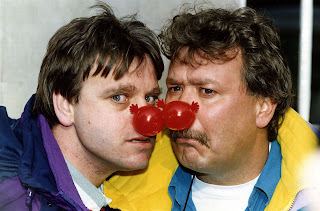1980s
The 1980s ushered in a couple of new genres of music. One was a contraction of Disco, which became ‘Dance’ music and the other was a soundtrack to a novel way of greeting someone with a wiggle of the hand called ‘new wave’.
Flares and massive pointy collars were no more but there were more men wearing make-up. Electronic music enjoyed a rise in popularity as did so called ‘Thrash’ metal which was the strange practice of strumming an electric guitar with as many effects on it as possible, as fast and as loud as possible. To be taken seriously whilst making all this noise, it was necessary to have a band name which conjoured up images of awful things; ‘Slayer’, ‘Megadeth’, ‘Anthrax’ and ‘Bucks Fizz’ all became popular somehow. Synthesizers were all the rage after all of Depeche Mode got one for their birthdays. This bleepy bloopy music then gave way to Electro, Techno, House and Whigfield for which none of us can ever forgive nor forget.
One thing the 80s got right was variety. It seemed that if you played an instrument or could sing a little bit, you had a chance of getting into the top 40. You could find almost any genre of music in the top 40 in the 1980s, not just pop and rock but reggae, R&B, hip hop, soul, glam rock, folk. singer songwriters, boy bands, girl bands, country, novelty acts, puppets, TV Theme tunes, instrumental film scores and St. Winifred’s School Choir. Even a Flock of Seagulls managed to get into the charts.
| They got their name when they all started fighting over a chip on the ground at the seaside |
Michael Jackson ruled in the 1980s as the King of Pop, Madonna took the title of Queen of Pop whilst Prince also released some music. MTV started showing pre-recorded promos of people doing things whilst singing their songs. They weren’t just standing on stage singing, these promos had a kind of story line like a short movie set to music. They called these things ‘videos’ and prompted the group ‘The Buggles’ to release a song called ‘Video killed the radio star’, which was the first musical murder mystery. Michael Jackson released ‘Thriller’ and made a ridiculously long video to go with it which involved werewolves and zombies. He was the first to do this although people thought Motorhead were first but as we know, the werewolves and zombies were actual members of the band.
At first Madonna was ‘like a virgin’ but by the end of the decade she was ‘like a prayer’. Teen pop had been prevalent in the 60s but only little Jimmy Osmond flew the flag in the 70s for the genre until Debbie Gibson and Tiffany inspired teenagers everywhere to go and put too much make-up on, get a stupid haircut and sing songs in their local shopping complex.
 |
| "I think we're alone now" ... "No, there are literally hundreds of people staring at you" |
 |
| "I simply can't do a thing with it" |
U2 weren’t the biggest band in the world in the 1980s, that accolade went to Earth, wind and fire who had 14 people in the band at one point. Genesis took over the charts in the 1980s with the band itself having many hits, Peter Gabriel and Phil Collins having many solo hits, Mike Rutherford scoring hits with his other band ‘Mike and the Mechanics’ and Tony thingy recording a song with Nik Kershaw in his garage. George Michael (by himself and with Wham! (in which he was also the sole musician)) scored hits (including six number ones) in many genres in the 1980s. He tried his hand at pop, soul, rap, disco and whatever genre ‘Faith’ is.
 |
| "Cos you gotta have face-a face-a face, I gotta have face-a face-a face-Ah!" |
 |
| Morten, looking a bit sketchy |
However, we also allowed Kylie Minogue to torture our ears so maybe the 80s weren’t as good as I remember.
 |
| The future of popular music |
This is an excerpt from the book 'The worst pop lyrics in the world EVER!' by Peter Nuttall. Available in Paperback and on Kindle here :
Barnes and Noble
Amazon
























